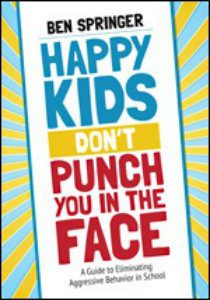Eliminating Aggressive Behavior in Your School
Happy Kids Don’t Punch You in the Face: A Guide to Eliminating Aggressive Behavior in School
By Ben Springer, PhD, NCSP
(Corwin, 2018 – Learn more)
At the start of my first year as a fourth grade teacher, I had a student who was angry, seemingly all the time. This anger often manifested itself in physical aggression. I was told that he had a mental health disorder diagnosis that explained why he was so angry, but I wasn’t given any tools to deal with it.
One day he had a violent outburst. I don’t remember what started it, and, honestly, it doesn’t even matter. All that matters is that he lost control and, in so doing, caused 27 classmates and one teacher to feel very, very scared.

The special education teacher came and got the rest of my class out of the room while I stood helplessly, watching this 10-year-old child yell and punch his fists into my brick walls.
Later, the special education teacher and I talked about the situation. We realized we needed some kind of exit plan for this young man when he was feeling like he was going to lose control.
I talked to our student the next day and asked him what he thought and, together, we worked out a plan: I would position his desk nearest the door and his best friend would sit right next to him. When the student felt like he was about to blow up, he had permission to simply get up and leave. He could go to the room of a trusted teacher who agreed to let him come in to cool down
Here’s the amazing thing: once we put this plan into place, this young man never once had another violent outburst while in my classroom. It was as if simply knowing he had an escape hatch was enough. This escape hatch allowed him to feel safe and, as a result, he was happy. Not only was he happy, but he began to thrive. I came to know him as an intelligent, funny, quick-witted, young man who made amazing connections and was determined to succeed.
Responding to disruptive students
I think that every teacher realizes, at some level or another, that our goal ought to be to have happy kids, but we don’t always have the words to explain why. We know that our students who get violent, who act out and use hurtful language, and who disrupt our classrooms tend to do so when they are unhappy. But what can we do to help them reach a state of happiness more often?
In Happy Kids Don’t Punch You in the Face, Ben Springer, PhD, NCSP, draws from his years of experience working with students with challenging behaviors to help teachers and school leaders understand how they can do just that. Combining anecdotes, research, and good old-fashioned common sense, Dr. Springer walks you through what doesn’t work and what you can try instead.
What doesn’t work
An unhappy child is often a coercive child who is trying to avoid work and will do just about anything, in the moment, to do so – including punching a teacher in the face. So what does not work when it comes to preventing a face punch from an unhappy student? Coercion, threats, physical punishment, verbal reprimands, suspensions, and expulsions.
As Springer so succinctly put it, “When the child becomes coercive [such as by having a nuclear meltdown to avoid a task], parents and teachers become more reluctant to make requests… In turn, the child has less and less practice responding appropriately to a request. We basically remove the child’s ability to improve by limiting their opportunities to be successful.”
In other words, adults tend to respond to aggressive actions by doing two incredibly stupid things: being aggressive themselves (either verbally or physically) and removing opportunities for children to learn from their mistakes by not even bothering to teach them what to do instead.
The happy kid formula
Fortunately, Springer has given us a much better formula for success. Rooted in the principles of applied behavioral analysis (ABA) and the RICH theory of happiness, the happy kids formula is a tool that reminds us that when students have access to resources and intimacy, feel competent about themselves, and are healthy, they are more likely to be happy, which will drastically decrease their levels of aggression.
As you and your team work together to conduct a functional behavioral analysis (FBA) and develop a Behavior Intervention Plan (BIP) for your students, you will find ways to support both them and their teachers in creating a happier, safer learning environment. Throughout this process, you will use multi-tiered systems of support (MTSS) to monitor implementation of your plans and make the necessary adjustments. And that’s it! You have the formula and now you are ready to take on the world, right?
Resources to support the process
For those whose eyes begin to glaze over when seeing acronyms such as ABA, RICH, FBA, BIP, and MTSS, have no fear! Springer’s book includes nearly two dozen appendices to walk you through the process! These resources are also perfect for the teacher who fully understands these acronyms but is looking for some ready-made forms to do a better job of collecting and tracking information.
And for those leaders who are ready to take the happy kids approach one step further and want to train their staff, Dr. Springer’s organization, TotemPD, offers training modules that can be done online or in person. (Be aware that, like every training organization on the face of the planet, you will be given a new acronym, ASPEN, to add to your arsenal. If you want to know what ASPEN stands for, you are going to have to either read the book or sign up for a training workshop with TotemPD.)
Not just for special needs kids
Too many educators think these approaches can only be used for those who have been identified with special needs and/or have an individualized education plan (IEP). But, as Springer reminds us, “while functional behavioral assessments (FBAs) and behavior intervention plans (BIPs) are certainly familiar to educators working in special education, they are not reserved just for special education students.”
“FBAs and BIPs can be applied to anything – literally anything –involving behavior. So regardless of whether or not the student exhibiting aggression is eligible for special education, use these strategies and get as much practice and input as you can with them.”
I literally loved everything about this book and cannot stop talking about it whenever I overhear a conversation about a challenging student. As I read my way through this book, I found myself jotting down useful quotes, telling others what I was learning, and pulling it out every time I spoke with an administrator in my district to tell them exactly why they and everyone on their staff needs to read this book now!
Alex T. Valencic, Ed.M., is the Curriculum Coordinator for 21st Century Teaching and Learning in Freeport, Illinois. He has taught professionally for over 10 years. When not coordinating the century by working with K-12 teachers who are implementing project-based learning and inquiry strategies to support student communication, collaboration, creativity, and critical thinking, Valencic can likely be found reading, riding his bicycle, or spending time with his family and friends playing tabletop games.You can learn more about his adventures in teaching fourth grade by visiting his blog Adventures in the 21st Century or by following him on Twitter @alextvalencic. This is his eighth book review for MiddleWeb.





































Wow! This sounds great! I am convinced! Buying a copy now!